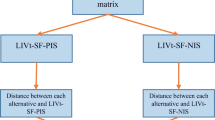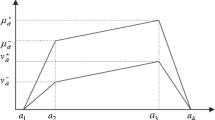Abstract
The concept of sponge city receives more and more attention by Chinese government, and the evaluation of sponge city construction is an important aspect. To cope with the complexity and uncertainty of the evaluation process, this paper adopts interval type-2 trapezoidal fuzzy numbers (IT2TFNs) to express decision-making information and develops an approach for evaluating sponge city construction. To do these, two prioritized-guided interval type-2 trapezoidal fuzzy Hamacher operators are first defined to infuse IT2TFNs offered by experts, which can cope with the situation where there is prioritization among experts/attributes. In order to further consider the interactions among experts/attributes, two generalized-Shapley interval type-2 trapezoidal fuzzy prioritized Hamacher Choquet integral operators are presented. To measure the discrimination degree between IT2TFNs, a new interval type-2 trapezoidal fuzzy cross-entropy is defined. After that, cross-entropy based models for obtaining the optimal fuzzy measure on the expert/attribute set are constructed to handle the situation where the weighting information is interactive and partly known. Furthermore, an interval type-2 trapezoidal fuzzy multi-attribute group decision-making approach is developed. Finally, a practical example about the evaluation of residential land design plans in sponge city is provided to illustrate the utilization of the new method, and comparison analysis is provided.

Similar content being viewed by others
Explore related subjects
Discover the latest articles, news and stories from top researchers in related subjects.References
Ayyildiz E, Gumus AT, Erkan M (2020) Individual credit ranking by an integrated interval type-2 trapezoidal fuzzy Electre methodology. Soft Comput 24(4):16149–16163
Benayoun R, Roy B, Sussman N (1966) Manual de reference du program ELECTRE. Note de Synthese et Formation, Paris, France. Direction Scientifique SEMA, No. 25
Chen TY (2011) Signed distanced-based TOPSIS method for multiple criteria decision analysis based on generalized interval-valued fuzzy numbers. Int J Inf Technol Dec Mak 10(6):1131–1159
Chen TY (2013) A signed-distance-based approach to importance assessment and multi-criteria group decision analysis based on interval type-2 fuzzy set. Knowl Inf Syst 35(1):193–231
Chen TY (2017) Multiple criteria decision analysis using prioritized interval type-2 fuzzy aggregation operators and its application to site selection. Technol Econ Dev Econ 23(1):1–21
Chen SM, Lee LW (2010) Fuzzy multiple attributes group decision-making based on the interval type-2 TOPSIS method. Expert Syst Appl 37(4):2790–2798
Chen LH, Xu ZS (2014) Prioritized measure-guided aggregation operators. IEEE Trans Fuzzy Syst 22(5):1127–1138
Chen TY, Chang CH, Lu JR (2013) The extended QUALIFLEX method for multiple criteria decision analysis based on interval type-2 fuzzy sets and applications to medical decision making. Eur J Oper Res 226(3):615–625
Fard SP, Zainuddin Z (2011) Interval type-2 fuzzy neural networks version of the Stone–Weierstrass theorem. Neurocomputing 74:2336–2343
Gomes LFAM, Lima MMPP (1992) TODIM: Basics and application to multicriteria ranking of projects with environmental impacts. Found Comput Dec Sci 16(4):113–127
Gong YB, Dai LL, Hu N (2016) Mutil-attribute decision making method based on bonferroni mean operator and possibility degree of interval type-2 trapezoidal fuzzy sets. Iran J Fuzzy Syst 15(5):97–115
Gong YB, Yang SX, Dai LL (2018) Some new signed distances and similarity measures of interval type-2 trapezoidal fuzzy numbers and comparative study. J Intell Fuzzy Syst 35(3):3465–3475
Grabisch M (1996) The application of fuzzy integrals in multi-criteria decision making. Eur J Oper Res 89(3):445–456
Hong YZ, Pasman HJ, Quddus N, SamMannan M (2020) Supporting risk management decision making by converting linguistic graded qualitative risk matrices through interval type-2 fuzzy sets. Process Saf Environ 134:308–322
Hu JH, Zhang Y, Chen XH, Liu YM (2013) Multi-criteria decision-making method based on possibility degree of interval type-2 fuzzy number. Knowl Based Syst 43(2):21–29
Hu J, Chen P, Yang Y, Liu Y, Chen X (2019) The fruit fly optimization algorithms for patient-centered care based on interval trapezoidal type-2 fuzzy numbers. Int J Fuzzy Syst 21(4):1270–1287
Ilker G (2020) An interval type-2 fuzzy reasoning model for digital transformation project risk assessment. Expert Syst Appl 159:113579
Karagöz S, Deveci M, Simic V, Aydin N (2021) Interval type-2 fuzzy ARAS method for recycling facility location problems. Appl Soft Comput 102:107107
Kasim K, Ercan A (2020) Aircraft selection by applying AHP and TOPSIS in interval type-2 fuzzy sets. J Air Transp Manag 89:101924
Lakshmanan S, Young Hoon J (2021) Design of interval type-2 fuzzy-based sampled-data controller for nonlinear Systems using novel fuzzy lyapunov functional and its application to PMSM. IEEE Trans Syst Man Cyber 51(1):542–551
Li Q, Wang F, Yu Y, Huang ZC, Li MT, Guan YT (2019) Comprehensive performance evaluation of LID practices for the sponge city construction: a case study in Guangxi, China. J Environ Manag 231:10–20
Liang CM, Zhang X, Xu J, Pan GY, Wang Y (2020) An integrated framework to select resilient and sustainable sponge city design schemes for robust decision making. Ecol Indic 119:106810
Liao HC, Si GS, Xu ZS, Fujita H (2018) Hesitant fuzzy linguistic preference utility set and its application in selection of fire rescue plans. Int J Environ Res Public Health 15(4):664
Liu PD, Gao H, Ma JH (2019) Novel green supplier selection method by combining quality function deployment with partitioned Bonferroni mean operator in interval type-2 fuzzy environment. Inf Sci 49:292–316
Ma XY, Wu P, Zhou LG, Chen HY, Zheng T, Ge JQ (2016) Approaches based on interval type-2 fuzzy aggregation operators for multiple attribute group decision making. Int J Fuzzy Syst 18(4):697–715
Ma YX, Wang JQ, Wang J, Wu XH (2017) An interval neutrosophic linguistic multi-criteria group decision-making method and its application in selecting medical treatment options. Neural Comput Appl 28(9):2745–2765
Marichal JL (2000) The influence of variables on pseudo-Boolean functions with applications to game theory and multicriteria decision making. Dis Appl Math 107:139–164
Mei KC, Peng Y, Mao JJ (2019) Comprehensive cross-entropy and entropy measures and their applications under interval type-2 fuzzy environment. J Intell Fuzzy Syst 37:5143–5156
Mendel JM, John RI (2002) Type-2 fuzzy sets made simple. IEEE Trans Fuzzy Syst 10(2):117–127
Mendel JM, John RI, Liu FL (2006) Interval type-2 fuzzy logic systems made simple. IEEE Trans Fuzzy Syst 14(6):808–821
Meng FY, Li ST (2020) A new multiple attribute decision making method for selecting design plans in sponge city construction with trapezoidal interval type-2 fuzzy information. Appl Intel 50:2252–2279
Meng FY, Tang J (2013) Interval-valued intuitionistic fuzzy multiattribute group decision making based on cross entropy measure and Choquet integral. Int J Intell Syst 28(12):1172–1195
Miao ZT, Han M, Hashemi S (2019) The effect of successive low-impact development rainwater systems on peak flow reduction in residential areas of Shizhuang. China Environ Earth Sci 78(2):51
Mittal K, Jain A, Vaisla KS, Castillo O, Kacprzyk J (2020) A comprehensive review on type 2 fuzzy logic applications: Past, present and future. Eng Appl Artif Intel 95:103916
Mousavi SM, Foroozesh N, Zavadskas EK, Antucheviciene J (2020) A new soft computing approach for green supplier selection problem with interval type-2 trapezoidal fuzzy statistical group decision and avoidance of information loss. Soft Comput 24:12313–12327
Nie RX, Wang JQ, Li L (2017) 2-tuple linguistic intuitionistic preference relation and its application in sustainable location planning voting system. J Intell Fuzzy Syst 33(2):885–899
Orlovsky S (1978) Decision-making with a fuzzy preference relation. Fuzzy Sets Syst 1(1):155–167
Pandey A, Kumar A (2017) A note on “A novel approach to multi attribute group decision making based on trapezoidal interval type-2 fuzzy soft sets.” Appl Math Model 41:691–693
Saaty TL (1980) The analytic hierarchy process. McGraw-Hill, New York
Santos J, Bressi S, Cerezo V, Lo Presti D (2019) Sup and rdss: a sustainability-based decision support system for road pavements. J Clean Prod 206:524–540
Shapley LS (1953) A value for n-person game. Ann Math Stud 28:307–318
Shukla AK, Nath R, Muhuri PK, Danish Lohani QM (2020) Energy efficient multi-objective scheduling of tasks with interval type-2 fuzzy timing constraints in an Industry 40 ecosystem. Eng Appl Artif Intel 87:103257
Sugeno M (1974) Theory of fuzzy integral and its application. Tokyo Institute of Technology, Tokyo
Sun WH, Li D, Liu P (2018) A decision-making method for sponge city design based on grey correlation degree and TOPSIS method. J Interdiscip Math 21(4):1031–1042
Tang GL, Chiclana F, Lin XC, Liu PD (2020) Interval type-2 fuzzy multi-attribute decision-making approaches for evaluating the service quality of Chinese commercial banks. Knowl Based Syst 193:105438
Turk S, Deveci M, Ozcan E, Canitez F, John R (2021) Interval type-2 fuzzy sets improved by simulated annealing for locating the electric charging stations. Inf Sci 547:641–666
Wang HH, Ju YB, Liu PD, Ju DW, Liu ZM (2018a) Some trapezoidal interval type-2 fuzzy Heronian mean operators and their application in multiple attribute group decision making. J Intell Fuzzy Syst 35(2):2323–2337
Wang HH, Liu PD, Liu ZM (2018b) Trapezoidal interval type-2 fuzzy MSM operators and their applications to multiple attribute group decision making. Int J Uncertain Quant 8(4):343–360
Wang H, Pan X, He S (2019) A new interval type-2 fuzzy VIKOR method for multi-attribute decision making. Int J Fuzzy Syst 21(1):145–156
Wang J, Li H, Yang H, Wang Y (2021) Intelligent multivariable air-quality forecasting system based on feature selection and modified evolving interval type-2 quantum fuzzy neural network. Environ Pollut 274:116429
Wu T, Liu X (2016) An interval type-2 fuzzy clustering solution for large-scale multiple-criteria group decision-making problems. Knowl Based Syst 114:118–127
Xiao B, Lam HK, Zhong Z, Wen S (2020) Membership-function-dependent stabilization of event-triggered interval type-2 polynomial fuzzy-model-based networked control systems. IEEE Trans Fuzzy Syst 28(12):3171–3180
Yager RR (2008) Prioritized aggregation operators. Int J Approx Reason 48(1):263–274
Yager RR (2012) On prioritized multiple-criteria aggregation. IEEE Trans Syst Man Cybern 42(5):1297–1305
Yao DB, Wang CC (2017) Interval type-2 fuzzy information measures and their applications to attribute decision-making approach. J Intell Fuzzy Syst 33(3):1809–1821
Yang HY, Wei B, Zhang XY, Shen YZ (2018) Fuzzy comprehensive evaluation in site selection for regulating storage tank of sponge city based on TFN-AHP. In: IEEE International conference on artificial intelligence big data. pp 281–286
Zadeh LA (1975) The concept of a linguistic variable and its application to approximate reasoning—I. Inf Sci 8(3):199–249
Zhang ZM (2018) Trapezoidal interval type-2 fuzzy aggregation operators and their application to multiple attribute group decision making. Neural Comput Appl 29(4):1039–1054
Zhang JY, Fu DF, Wang YJ, Singh RP (2017) Detailed sponge city planning hbased on hierarchical fuzzy decision-making: a case study on Yangchen Lake. Water 9(11):903
Acknowledgements
This work was supported by the Startup Foundation for Introducing Talent of NUIST (No. 2020r001), and the Major Project for National Natural Science Foundation of China (No. 72091515).
Author information
Authors and Affiliations
Corresponding author
Additional information
Publisher's Note
Springer Nature remains neutral with regard to jurisdictional claims in published maps and institutional affiliations.
Appendices
Appendix 1: Hamacher operations on IT2TFNs
Let \(\tilde{A}_{1}\) = (\(\tilde{A}_{1}^{U}\), \(\tilde{A}_{1}^{L}\)) = (\(a_{11}^{U}\), \(a_{12}^{U}\), \(a_{13}^{U}\), \(a_{14}^{U}\); \(H(\tilde{A}_{1}^{U} )\)), (\(a_{11}^{L}\), \(a_{12}^{L}\), \(a_{13}^{L}\), \(a_{14}^{L}\); \(H(\tilde{A}_{1}^{L} )\)) and \(\tilde{A}_{2}\) = (\(\tilde{A}_{2}^{U}\), \(\tilde{A}_{2}^{L}\)) = (\(a_{21}^{U}\), \(a_{22}^{U}\), \(a_{23}^{U}\), \(a_{24}^{U}\); \(H(\tilde{A}_{2}^{U} )\)), (\(a_{21}^{L}\), \(a_{22}^{L}\), \(a_{23}^{L}\), \(a_{24}^{L}\); \(H(\tilde{A}_{2}^{L} )\)) be two non-negative IT2TFNs, where \(a_{14}^{U} ,a_{24}^{U} \le 1\), and \(\gamma > 0\). The Hamacher operations between \(\tilde{A}_{1}\) and \(\tilde{A}_{2}\) are defined as follows (Meng and Li 2020):
Appendix 2: The normalization of IT2TFNs.
Let \(\tilde{A}_{i}\) = (\(\tilde{A}_{i}^{U}\), \(\tilde{A}_{i}^{L}\)) = (\(a_{i1}^{U}\), \(a_{i2}^{U}\), \(a_{i3}^{U}\), \(a_{i4}^{U}\); \(H(\tilde{A}_{i}^{U} )\)), (\(a_{i1}^{L}\), \(a_{i2}^{L}\), \(a_{i3}^{L}\), \(a_{i4}^{L}\); \(H(\tilde{A}_{i}^{L} )\)), i = 1, 2, …, n, be a collection of IT2TFNs.\(\tilde{A}_{i}\) is normalized into \(\tilde{A}_{i}^{\prime \prime }\) by the following formula (Meng and Li 2020):
where \(a_{m}\) = \(\max a_{i4}^{U}\), and \(H_{m}\) = \(\max H(\tilde{A}_{i}^{U} )\) for all i = 1, 2, …, n.
Rights and permissions
About this article
Cite this article
Meng, F., Li, S. & Tang, J. A new interval type-2 trapezoid fuzzy multi-attribute group decision-making method and its application to the evaluation of sponge city construction. Artif Intell Rev 54, 4063–4096 (2021). https://doi.org/10.1007/s10462-021-10022-2
Published:
Issue Date:
DOI: https://doi.org/10.1007/s10462-021-10022-2




